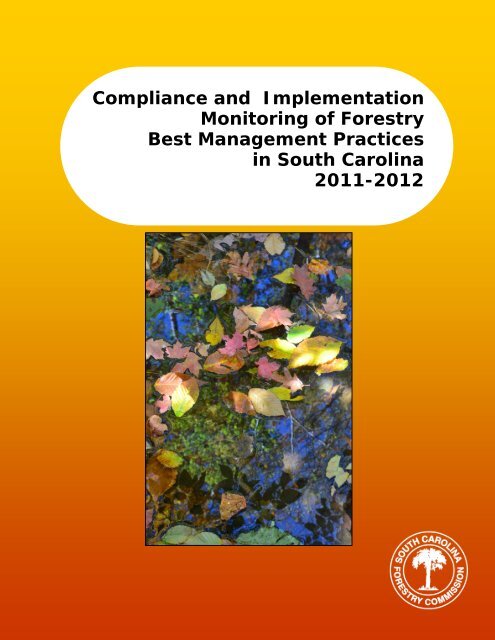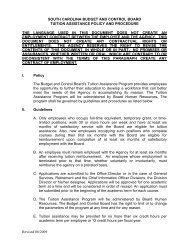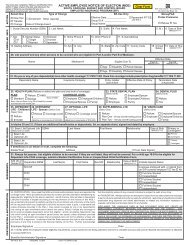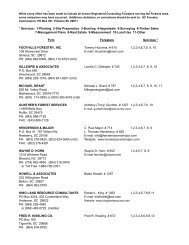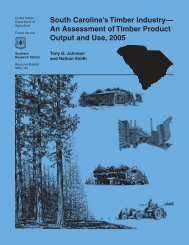2011-12 BMP Monitoring Report
2011-12 BMP Monitoring Report
2011-12 BMP Monitoring Report
Create successful ePaper yourself
Turn your PDF publications into a flip-book with our unique Google optimized e-Paper software.
Compliance and Implementation<br />
<strong>Monitoring</strong> of Forestry<br />
Best Management Practices<br />
in South Carolina<br />
<strong>2011</strong>-20<strong>12</strong>
Compliance and<br />
Implementation <strong>Monitoring</strong><br />
of<br />
Forestry Best Management Practices<br />
in South Carolina<br />
<strong>2011</strong>-20<strong>12</strong><br />
Guy Sabin<br />
Environmental Program Manager<br />
South Carolina Forestry Commission<br />
Best Management Practices<br />
<strong>Monitoring</strong> <strong>Report</strong> <strong>BMP</strong>-8<br />
Published by the South Carolina Forestry Commission, Columbia, SC December 20<strong>12</strong><br />
This project was funded in part by the US Environmental Protection<br />
Agency under a Section 319 grant through the South Carolina<br />
Department of Health & Environmental Control.<br />
Compliance and Implementation <strong>Monitoring</strong> <strong>2011</strong>-20<strong>12</strong> Page 1
Table of Contents<br />
Executive Summary…….……………………………………………………... 3<br />
Introduction………………………………………………………………………. 5<br />
Study Methods…………………………………………………………………... 6<br />
<strong>Monitoring</strong> Results for Harvesting………………………………….…… . 9<br />
<strong>Monitoring</strong> Results for Non-Harvest Operations…………………… . 11<br />
Landowner and Site Information………………………………………... . 14<br />
Compliance Trends………………………………………………………….… . 14<br />
Conclusion………………………………………………………………………… 18<br />
Appendix – Data Forms………………………………………………………. 20<br />
Page 2<br />
Compliance and Implementation <strong>Monitoring</strong> <strong>2011</strong>-20<strong>12</strong>
EXECUTIVE SUMMARY<br />
This is the ninth study conducted by the South Carolina Forestry Commission to<br />
determine compliance with South Carolina Best Management Practices for Forestry<br />
(<strong>BMP</strong>s) during silvicultural activities. Forest operations were evaluated on 151<br />
randomly located sites during <strong>2011</strong>-20<strong>12</strong>.<br />
Overall <strong>BMP</strong> compliance on harvesting operations was 93.4%. Compliance indicates<br />
that the proper use of applicable <strong>BMP</strong>s was sufficient to protect water quality on<br />
those sites. <strong>BMP</strong> compliance for non-harvesting operations was 87.5%. This<br />
includes mechanical and chemical site preparation, pesticide and fertilizer<br />
application, prescribed burning, reforestation, and minor drainage. The overall<br />
implementation rate of individual <strong>BMP</strong> practices was 92.1%, compared to the<br />
regional average of 92% among southeastern states.<br />
This study highlights numerous strengths in <strong>BMP</strong> compliance:<br />
<br />
<br />
<br />
<br />
High overall compliance with <strong>BMP</strong>s to protect water quality during forestry<br />
operations.<br />
Improved landowner awareness of <strong>BMP</strong>s, and increased use of written<br />
contracts that require <strong>BMP</strong> compliance.<br />
Excellent compliance with <strong>BMP</strong>s related to Road Systems which often have<br />
a high potential for water quality impacts.<br />
Streamside Management Zones are frequently wider than the minimum<br />
recommendations on perennial and intermittent streams.<br />
Opportunities for improvement include:<br />
<br />
<br />
<br />
Increased attention is needed on firebreak lines, especially on steep slopes<br />
and near water bodies.<br />
Stream crossings and streamside management zones present the greatest<br />
opportunities for improving compliance.<br />
The most important individual practices for improvement are:<br />
Retain appropriate overstory trees within Streamside Management<br />
Zones,<br />
Compliance and Implementation <strong>Monitoring</strong> <strong>2011</strong>-20<strong>12</strong> Page 3
Stabilize disturbed soil at stream crossings,<br />
Keep road and ditch runoff out of streams,<br />
Control erosion on skid trails,<br />
Protect intermittent and ephemeral streams during skidding,<br />
Minimize the number of stream crossings,<br />
Avoid excessive rutting,<br />
Take steps to prevent depositing mud on roads,<br />
Stabilize firebreak lines and avoid tying lines in with streams.<br />
The results of this study will be used to target training programs, outreach, and<br />
technical assistance in order to seek continual improvement in <strong>BMP</strong> compliance and<br />
implementation in South Carolina and further advance successful protection of<br />
water quality during forestry operations.<br />
Page 4 Compliance and Implementation <strong>Monitoring</strong> <strong>2011</strong>-20<strong>12</strong>
INTRODUCTION<br />
The South Carolina Forestry Commission promotes compliance with South<br />
Carolina’s Best Management Practices for Forestry (<strong>BMP</strong>s) through training<br />
programs, <strong>BMP</strong> Courtesy Exams, technical assistance, and regular monitoring. The<br />
<strong>BMP</strong> program is funded in part by the US Environmental Protection Agency under a<br />
Section 319 nonpoint source pollution control grant through the South Carolina<br />
Department of Health and Environmental Control.<br />
Additional support for <strong>BMP</strong> compliance is provided through forest industry including<br />
the Sustainable Forestry Initiative Program and Timber Operations Professional<br />
(TOP) logger training program. Partners such as the South Carolina Forestry<br />
Association, South Carolina Timber Producers Association, Clemson University, and<br />
USDA Forest Service contribute to a successful program. Relationships with<br />
regulatory agencies including SCDHEC, US Army Corps of Engineers, and EPA also<br />
strengthen <strong>BMP</strong> compliance.<br />
The results of this study will be used to target training programs, outreach, and<br />
technical assistance in order to seek continual improvement in <strong>BMP</strong> compliance and<br />
implementation in South Carolina and further advance successful protection of<br />
water quality during forestry operations.<br />
Compliance and Implementation <strong>Monitoring</strong> <strong>2011</strong>-20<strong>12</strong> Page 5
STUDY METHODS<br />
During <strong>2011</strong> and 20<strong>12</strong>, 151 recent forestry activities were evaluated for compliance<br />
and implementation of <strong>BMP</strong>s. A regional protocol for a consistent, credible, and<br />
statistically valid reporting process is presented in “Silviculture Best Management<br />
Practices Implementation <strong>Monitoring</strong> – A Framework for State Forestry<br />
Agencies,” (Southern Group of State Foresters Water Resources Committee, 2007).<br />
This survey meets or exceeds all standards of the regional protocol.<br />
Sample Size<br />
Sample size was determined using the “Statistical Guide for <strong>BMP</strong> Implementation<br />
<strong>Monitoring</strong>,” (Southern Group of State Foresters Water Resources Committee,<br />
2006). With an estimated implementation rate of 90%, a sample size of 144 sites<br />
would be needed to achieve the desired 5% margin of error within the 95%<br />
confidence interval. Based on the sample size and results, actual margin of error<br />
was calculated to be 4.15% at the state level.<br />
Site Selection<br />
Sites were selected by aerial surveys to minimize bias. First, a target number of<br />
survey sites were identified for each county in proportion to the annual timber<br />
harvest reported in US Forest Service Timber Product Output data. Randomly<br />
located transects were flown until twice the desired number of silvicultural activities<br />
were located. Silvicultural activities selected were at least 10 acres in size and<br />
conducted within the previous six months. No association with streams or wetland<br />
areas was required to be included as a monitoring site. Within each county, a<br />
random number generator was used to select half of the identified sites for inclusion<br />
in the study.<br />
Landowner Questionnaire<br />
Once a site was selected for inclusion in the monitoring study, the local <strong>BMP</strong><br />
Forester contacted the landowner to obtain permission to visit the site. Prior to the<br />
site inspection, each landowner was questioned about their level of familiarity with<br />
Forestry <strong>BMP</strong>s, use of a professional forester, and use of a written contract. Four<br />
categories of landowners were identified for the purpose of this study:<br />
1. Non-industrial landowners who own less than 1,000 acres of forest land,<br />
Page 6<br />
Compliance and Implementation <strong>Monitoring</strong> <strong>2011</strong>-20<strong>12</strong>
2. Non-industrial landowner who own more than 1,000 acres of forest land,<br />
3. Public lands, owned or managed by local, state, or federal government,<br />
4. Industrial lands, owned by forest products companies and timberland<br />
investment groups.<br />
Site Evaluation<br />
Site inspections were done by four specially trained <strong>BMP</strong> Foresters. On each<br />
harvesting site up to 109 applicable <strong>BMP</strong>s were evaluated for successful<br />
implementation. On non-harvest sites, 48 individual practices were evaluated as<br />
applicable to Site Preparation, Reforestation, Prescribed Burning, Pesticide<br />
Application, Fertilizer Application, and Minor Drainage.<br />
Each individual <strong>BMP</strong> practice was rated as Yes, No, Significant Risk, or Not<br />
Applicable.<br />
<br />
<br />
<br />
<br />
Yes – the individual practice was applicable and properly applied.<br />
No – the individual practice was applicable, but not applied or not<br />
applied correctly.<br />
Significant Risk – the individual practice was applicable, and failure to<br />
properly apply the practice resulted in the potential for water quality<br />
impacts if not corrected.<br />
Not Applicable – the individual practice was not necessary for that site.<br />
Based on these individual practices, five categories of <strong>BMP</strong>s were rated for<br />
compliance. Each category was rated based on whether compliance was sufficient<br />
to protect water quality, and provides an assessment of whether water quality<br />
impacts occurred on the site. <strong>BMP</strong> categories are:<br />
1. Streamside Management Zones<br />
2. Stream Crossings<br />
3. Road Systems<br />
4. Harvesting Systems – Water Quality<br />
5. Harvesting Systems – Site Productivity<br />
Overall <strong>BMP</strong> compliance for each site was determined after all individual practices<br />
and <strong>BMP</strong> categories were fully evaluated. Each site was given an overall rating of<br />
Excellent, Adequate, or Inadequate depending on the level of <strong>BMP</strong> compliance, as<br />
follows:<br />
Compliance and Implementation <strong>Monitoring</strong> <strong>2011</strong>-20<strong>12</strong> Page 7
Excellent Compliance – All recommended <strong>BMP</strong>s were implemented<br />
successfully, and no water quality impacts resulted from the operation.<br />
Significant additional steps were taken to stabilize the site, reduce<br />
potential impacts to water quality or site quality, or to mitigate aesthetic<br />
impacts.<br />
Adequate Compliance – Recommended <strong>BMP</strong>s were sufficiently<br />
implemented to prevent water quality impacts from the overall operation.<br />
Inadequate Compliance – Recommended <strong>BMP</strong>s were not implemented or<br />
were implemented without success. Likely water quality impacts were<br />
noted as a result of poor or improper <strong>BMP</strong> implementation.<br />
Compliance and Implementation<br />
Determination of Excellent, Adequate, or Inadequate compliance with <strong>BMP</strong>s was<br />
closely linked with the likelihood or presence of water quality impacts, and was<br />
consistent with applicable state and federal water quality laws and regulations.<br />
This study also includes implementation rates which refer to the percentage of<br />
applicable individual practices that were properly applied on the site for each<br />
category and overall. Therefore, the implementation rate indicates the level at<br />
which <strong>BMP</strong>s were properly applied, and the compliance rate indicates whether the<br />
applied practices successfully protected water quality.<br />
Quality Assurance Checks<br />
The <strong>BMP</strong> coordinator performed quality checks on 10% of evaluated sites to ensure<br />
consistency. Checks were completed while monitoring was ongoing so any<br />
corrections could be immediately<br />
applied. Modifications were made<br />
for six individual responses due to<br />
quality checks. The most common<br />
issue was identification of Significant<br />
Risk for individual practices, most<br />
likely because this rating is not used<br />
during normal Courtesy Exams<br />
routinely done by <strong>BMP</strong> Foresters.<br />
Compliance ratings for <strong>BMP</strong><br />
categories were highly consistent.<br />
Page 8<br />
Compliance and Implementation <strong>Monitoring</strong> <strong>2011</strong>-20<strong>12</strong>
MONITORING RESULTS<br />
FOR HARVESTING<br />
Streamside Management Zones – 91.9% Compliance<br />
Perennial or intermittent streams were present on 48% of the sites included in this<br />
monitoring survey. The standard SC <strong>BMP</strong> recommendation for SMZ width on<br />
perennial streams is 40’. Perennial streams in the survey were found to have an<br />
average SMZ width of 62’ and median width of 50’. Many intermittent streams<br />
were also protected with a buffer of overstory trees. No trout waters or braided<br />
stream systems were identified in this survey. Compliance with <strong>BMP</strong>s for<br />
Streamside Management Zones was sufficient to protect water quality on 91.9% of<br />
sites. Six sites were rated as having inadequate compliance in this category.<br />
A total of 814 applicable <strong>BMP</strong>s were evaluated with 94.6% implementation. Fortyfour<br />
individual practices were not properly applied, 9 of those with Significant Risk.<br />
The most common deficiency was failure to retain appropriate overstory trees<br />
within the SMZ. Additional concerns included excessive debris in stream channels,<br />
excessive rutting within the SMZ, skidding within ephemeral areas except at<br />
crossings, and altering water flow in ephemeral areas.<br />
Stream Crossings – 81.0% Compliance<br />
Thirty-eight stream crossings were<br />
evaluated on twenty-one different<br />
sites. Most crossings were skid<br />
trail debris crossings, though five<br />
road culvert and bridge<br />
installations were also evaluated.<br />
Compliance with <strong>BMP</strong>s for Stream<br />
Crossings was sufficient to protect<br />
water quality on 81.0% of sites.<br />
Four sites were rated with<br />
inadequate compliance in this<br />
category.<br />
A total of 133 applicable <strong>BMP</strong>s<br />
Compliance and Implementation <strong>Monitoring</strong> <strong>2011</strong>-20<strong>12</strong><br />
Page 9
were evaluated with 83.5% implementation. Twenty-two individual practices were<br />
not properly applied, four of those with Significant Risk. Major issues were failure<br />
to stabilize disturbed soil at crossings after construction, and failure to keep road<br />
and ditch runoff out of streams at crossings.<br />
Road Systems – 98.1% Compliance<br />
Road systems were evaluated on 106 sites, with existing roads being used on all<br />
but 13 sites which had new road construction. One silvicultural wetland road was<br />
evaluated. Compliance with <strong>BMP</strong>s for road systems was sufficient to protect water<br />
quality on 98.1% of sites. Two sites were rated with inadequate compliance in this<br />
category.<br />
A total of 606 applicable <strong>BMP</strong>s were evaluated with 92.1% implementation. Fortyeight<br />
individual practices were not properly applied, four of those with Significant<br />
Risk. Primary concerns were failure to stabilize roads with water control structures<br />
after the operation and failure to stabilize exposed soil after construction.<br />
Harvesting Systems – 94.1% Compliance<br />
<strong>BMP</strong>s for Harvesting are separated into practices related to water quality and those<br />
related to non-water quality site impacts. Harvesting was evaluated on 136 sites,<br />
and compliance with <strong>BMP</strong>s was sufficient to protect water quality on 94.1% of<br />
those. Compliance with <strong>BMP</strong>s was sufficient to prevent non-water quality site<br />
impacts on 98.5% of sites. Eight sites were rated with inadequate compliance<br />
related to water quality, and two sites were rated with inadequate compliance<br />
related to site impacts in this category. The combined compliance rating for<br />
harvesting systems related to both water quality and on-site impacts was 96.3%.<br />
A total of 2,079 applicable harvesting <strong>BMP</strong>s were evaluated with 91.7%<br />
implementation. 173 individual practices were not properly applied, 14 of those<br />
with significant risk.<br />
Major deficiencies related to water quality were failure to control erosion on skid<br />
trails with waterbars or seed. Additional areas of concern include skidding over<br />
intermittent or ephemeral streams without appropriate protection, use of fill in<br />
debris crossings, avoiding sensitive areas, and failure to minimize the number of<br />
stream crossings. Primary concerns related to non-water quality impacts included<br />
failure to prevent depositing mud on roads, excessive rutting, and harvesting when<br />
site conditions were too wet.<br />
Page 10<br />
Compliance and Implementation <strong>Monitoring</strong> <strong>2011</strong>-20<strong>12</strong>
Overall Harvesting Compliance– 93.4%<br />
Overall <strong>BMP</strong> compliance on harvested sites was sufficient to protect water quality on<br />
93.4% of sites. A total of nine sites were found to have inadequate <strong>BMP</strong> compliance with<br />
potential water quality impacts.<br />
Of the 136 harvesting sites evaluated, 100 were clearcut and 36 were thinned or partially<br />
cut. Thinned sites had an overall compliance rating of 100%, though significant risks<br />
were noted on three sites for excessive rutting, failure to remove a temporary crossing,<br />
and skidding within a Streamside Management Zone.<br />
On harvested sites, 3,632 individual practices were evaluated. Of that number, 3,345<br />
practices were properly applied and 287 practices were not, thirty-one of those with<br />
significant risk. Total implementation rate for all practices was 92.1%.<br />
MONITORING RESULTS<br />
FOR NON-HARVEST OPERATIONS<br />
Non-harvest forest operations include site preparation, reforestation, prescribed<br />
burning, pesticide application, fertilizer application, and minor drainage. A total of<br />
16 sites in this survey included non-harvest operations. Additional information on<br />
non-harvest operations will be collected on all 151 sites in this study during followup<br />
visits for the next two years. These results for non-harvest activities should be<br />
considered preliminary due to the small sample size and ongoing data collection.<br />
Site Preparation – 92.9% Compliance<br />
Site preparation operations were evaluated on fourteen sites, including five sites<br />
with mechanical site preparation, eight with chemical, and one prescribed burning.<br />
Compliance with site preparation <strong>BMP</strong>s was sufficient to protect water quality on<br />
92.9% of sites. One site was rated with inadequate compliance in this category.<br />
A total of 35 applicable practices were evaluated with 88.6% implementation. Four<br />
individual practices were not properly applied, none with significant risk. The major<br />
deficiency was failure to prevent erosion in firebreaks.<br />
Reforestation – 100% Compliance<br />
Reforestation activities were evaluated on ten sites, including six machine planted<br />
Compliance and Implementation <strong>Monitoring</strong> <strong>2011</strong>-20<strong>12</strong><br />
Page 11
and four hand planted sites. Compliance with <strong>BMP</strong>s related to reforestation was<br />
100%.<br />
A total of 19 applicable <strong>BMP</strong>s related to reforestation were evaluated with 94.7%<br />
implementation. Failure to avoid leaving planting bags or garbage was noted on<br />
one site.<br />
Prescribed Burning – 60% Compliance<br />
Prescribed burning was evaluated on five<br />
sites, and compliance with <strong>BMP</strong>s was<br />
sufficient to protect water quality on 60%<br />
of those. Two sites were rated with<br />
inadequate compliance in this category.<br />
A total of 26 applicable <strong>BMP</strong>s were<br />
evaluated with 80.8% implementation.<br />
Inadequate ratings were given for failure<br />
to stabilize firebreaks where needed and<br />
failure to use hand tools to tie firebreaks<br />
into stream channels.<br />
Pesticide Application – 100% Compliance<br />
Pesticide application was evaluated on eight sites, and compliance with <strong>BMP</strong>s was<br />
sufficient to protect water quality on 100% of sites. A total of 44 applicable <strong>BMP</strong>s<br />
were evaluated with 100% implementation. No sites in this survey were identified<br />
with fertilizer application.<br />
Minor Drainage – 100% Compliance<br />
Three operations in this survey included activity related to pre-existing minor<br />
drainage. No new minor drainage was identified. Compliance with <strong>BMP</strong>s related to<br />
minor drainage was sufficient to protect water quality on 100% of sites. A total of<br />
24 applicable <strong>BMP</strong>s were evaluated with 100% implementation.<br />
Page <strong>12</strong><br />
Compliance and Implementation <strong>Monitoring</strong> <strong>2011</strong>-20<strong>12</strong>
Overall Non-harvesting Compliance – 87.5%<br />
Compliance with non-harvesting <strong>BMP</strong>s was sufficient to protect water quality<br />
on 87.5% of the sixteen sites evaluated. Two sites were rated with inadequate<br />
compliance and potential water quality impacts. Both inadequate sites were<br />
because of erosion from firebreaks.<br />
A total of 148 applicable non-harvest <strong>BMP</strong>s were evaluated with 93.2%<br />
implementation. Ten individual practices were not properly applied.<br />
Compliance and Implementation <strong>Monitoring</strong> <strong>2011</strong>-20<strong>12</strong><br />
Page 13
LANDOWNER AND SITE INFORMATION<br />
Prior to site visits, contact was made with each landowner to request<br />
access and ask questions about the activity on their property. Additional data was<br />
collected during site visits to look for relationships between <strong>BMP</strong> compliance and<br />
site factors such as physiographic region and soil texture.<br />
All landowners reported using a written contract for their forest operation, and 89%<br />
of those required <strong>BMP</strong> compliance in that contract. This is a marked increase from<br />
the last monitoring study in 2009, when 92% of landowners had a written contract<br />
and only 62% of those required <strong>BMP</strong> compliance. In addition, nonindustrial private<br />
landowners with less than 1,000 acres reporting familiarity with <strong>BMP</strong>s increased<br />
from 31% to 41%. This indicates that landowner awareness and understanding of<br />
<strong>BMP</strong>s is growing, and that landowners and forestry professionals are increasingly<br />
likely to include <strong>BMP</strong> compliance in written contracts.<br />
Forest operations were evaluated on a total of 8,749 acres in this survey. The<br />
average size operation was 61.2 acres, compared to 73 acres in 2009.<br />
Although compliance was slightly lower in the Carolina sandhills and southern<br />
piedmont, no significant patterns were identified by physiographic region, terrain,<br />
or soil type.<br />
COMPLIANCE TRENDS<br />
Harvesting Compliance Trends<br />
Overall compliance with <strong>BMP</strong>s during harvesting operations was 93.4% (Table 1).<br />
Although this represents a drop from 98.6% in 2009, overall compliance remains<br />
high. The overall ratings indicate that landowners, loggers, and forestry<br />
professionals are committed to protecting water quality with proper application of<br />
Best Management Practices.<br />
Page 14<br />
Compliance and Implementation <strong>Monitoring</strong> <strong>2011</strong>-20<strong>12</strong>
Harvesting <strong>BMP</strong> Compliance by Year<br />
100<br />
90<br />
84.5 84.7<br />
89.5<br />
91.5<br />
94<br />
98 98.6<br />
93.4<br />
Percent Compliance<br />
80<br />
70<br />
60<br />
50<br />
1991 1993 1994 2000 2005 2006 2009 20<strong>12</strong><br />
Percent Compliance<br />
Table 1. Harvesting <strong>BMP</strong> Compliance by year of monitoring report publication.<br />
The overall implementation rate for <strong>BMP</strong>s during harvesting operations was 92.1%,<br />
compared to the southern regional average of 92%. Most states in the south report<br />
<strong>BMP</strong> implementation rather than compliance, so this number can be compared with<br />
regional results for eleven southern states (Implementation of Forestry Best<br />
Management Practices: 20<strong>12</strong> Southern Region <strong>Report</strong>, September 20<strong>12</strong>, Southern<br />
Group of State Foresters Water Resources Committee). Implementation of <strong>BMP</strong>s in<br />
South Carolina is consistent with the region.<br />
Every category except Stream Crossings had compliance above 90% (Table 2).<br />
Stream Crossings and Streamside Management Zones have historically been the<br />
categories with lowest compliance, and continue to be the areas with greatest<br />
opportunity for improvement. Both of these categories are critical for water quality<br />
protection since they often involve use of heavy equipment and soil disturbance<br />
near water bodies.<br />
The individual practices most likely to be absent or improperly applied included<br />
retaining overstory trees in SMZs, stabilization, proper construction of stream<br />
crossings, and road entrances suitable to prevent mud on roads. All of these<br />
activities are prone to economic influence and efforts to reduce logging costs.<br />
Compliance and Implementation <strong>Monitoring</strong> <strong>2011</strong>-20<strong>12</strong><br />
Page 15
Public and Industrial ownerships demonstrate high levels of <strong>BMP</strong> compliance (Table<br />
3). Private ownership, both small and large, showed a slight decline but both<br />
remain above 90%.<br />
Harvesting <strong>BMP</strong> Compliance Trends by<br />
Category<br />
100<br />
90<br />
80<br />
Percent Compliance<br />
70<br />
60<br />
50<br />
40<br />
30<br />
20<br />
10<br />
0<br />
1993 1994 2000 2005 2006 2009 20<strong>12</strong><br />
Roads<br />
Harvest Systems<br />
SMZs<br />
Stream Crossings<br />
Table 2. Harvesting <strong>BMP</strong> Compliance trends by category.<br />
Harvesting <strong>BMP</strong> Compliance Trends by<br />
Ownership<br />
100<br />
95<br />
90<br />
Percent Compliance<br />
85<br />
80<br />
75<br />
70<br />
65<br />
Public<br />
Industry<br />
NIPF1000<br />
60<br />
55<br />
50<br />
1991 1993 1994 2000 2005 2006 2009 20<strong>12</strong><br />
Table 3. Harvesting <strong>BMP</strong> compliance trends by ownership.<br />
Page 16<br />
Compliance and Implementation <strong>Monitoring</strong> <strong>2011</strong>-20<strong>12</strong>
Non-harvest <strong>BMP</strong> Compliance Trends<br />
Non-harvest forest operations include mechanical and chemical site preparation,<br />
pesticide and fertilizer application, prescribed burning, reforestation, and minor<br />
drainage. Overall compliance with non-harvest <strong>BMP</strong>s is 87.5% (Table 4), though<br />
this is based on a small sample size. A more accurate measure of compliance will<br />
develop as follow-up visits are conducted to the sites in this study over the next two<br />
years and additional activities are evaluated. Non-harvest compliance results<br />
should be considered preliminary until follow-up visits are completed.<br />
Non-harvest compliance was 100% for the categories of reforestation, chemical<br />
application, and minor drainage (Table 5). No sites with fertilizer application were<br />
identified. Prescribed burning had the lowest compliance at 60%, primarily because<br />
of failure to stabilize firebreak lines and tying firebreak lines into streams.<br />
Overall Nonharvest Compliance by Year<br />
100<br />
90<br />
86.4<br />
98<br />
96<br />
87.5<br />
Percent Compliance<br />
80<br />
70<br />
60<br />
50<br />
1996 2000 2005 20<strong>12</strong><br />
Overall Nonharvest Compliance<br />
Table 4. Overall non-harvesting <strong>BMP</strong> Compliance by year of monitoring report publication.<br />
Compliance and Implementation <strong>Monitoring</strong> <strong>2011</strong>-20<strong>12</strong><br />
Page 17
Nonharvest <strong>BMP</strong> Compliance Trends by<br />
Category<br />
Percent Compliance<br />
100<br />
90<br />
80<br />
70<br />
60<br />
50<br />
40<br />
30<br />
Chemical Application<br />
Reforestation<br />
Minor Draiage<br />
Mechanical Site Prep<br />
Prescribed Burning<br />
20<br />
1996 2000 2005 20<strong>12</strong><br />
Table 5. Non-harvest <strong>BMP</strong> compliance trends by category.<br />
CONCLUSION<br />
The results of this study demonstrate the continuing success of<br />
compliance and implementation with South Carolina’s Best Management Practices<br />
for Forestry by landowners, loggers, and forestry professionals.<br />
This study highlights numerous strengths in <strong>BMP</strong> compliance:<br />
<br />
<br />
<br />
<br />
High overall compliance with <strong>BMP</strong>s to protect water quality during forestry<br />
operations.<br />
Improved landowner awareness of <strong>BMP</strong>s, and increased use of written<br />
contracts that require <strong>BMP</strong> compliance.<br />
Excellent compliance with <strong>BMP</strong>s related to Road Systems which often have<br />
a high potential for water quality impacts.<br />
Streamside Management Zones are frequently wider than the minimum<br />
recommendations on perennial and intermittent streams.<br />
The results of this study will also be used to target training programs, outreach,<br />
Page 18<br />
Compliance and Implementation <strong>Monitoring</strong> <strong>2011</strong>-20<strong>12</strong>
and technical assistance to continually improve compliance. Opportunities for<br />
improvement include:<br />
<br />
<br />
<br />
<br />
Increased attention is needed on firebreak lines, especially on steep slopes<br />
and near water bodies.<br />
Stream crossings and streamside management zones present opportunities<br />
for improving compliance.<br />
The most important individual practices for improvement are:<br />
Retain appropriate overstory trees within Streamside Management<br />
Zones,<br />
Stabilize disturbed soil at stream crossings,<br />
Keep road and ditch runoff out of streams,<br />
Control erosion on skid trails,<br />
Minimize the number of stream crossings,<br />
Protect intermittent and ephemeral streams during skidding,<br />
Avoid excessive rutting,<br />
Take steps to prevent depositing mud on roads,<br />
Stabilize firebreak lines and avoid tying lines in with streams.<br />
Some <strong>BMP</strong> practices are not frequently encountered in randomly selected<br />
sites. Activities such as firebreak lines, wetland roads, fertilizer<br />
application, and braided stream protection may require further review.<br />
Over the next two years, follow-up visits to the sites in the study will provide<br />
additional information on the outcome of <strong>BMP</strong> practices over time and the shortterm<br />
recovery of sites after forestry operations. Follow-up visits will address issues<br />
such as blow down in SMZs, revegetation of exposed soil, and evaluation of any<br />
new forestry activities. Evaluation of additional post-harvest activities such as site<br />
preparation, reforestation, and prescribed burning will improve the sample size and<br />
accuracy of those ratings.<br />
The results of this study will be used<br />
to seek continual improvement in <strong>BMP</strong><br />
compliance and implementation in<br />
South Carolina, and further advance<br />
successful protection of water quality<br />
during forestry operations.<br />
Compliance and Implementation <strong>Monitoring</strong> <strong>2011</strong>-20<strong>12</strong><br />
Page 19
APPENDIX<br />
<strong>Monitoring</strong> Data Forms<br />
Page 20<br />
Compliance and Implementation <strong>Monitoring</strong> <strong>2011</strong>-20<strong>12</strong>
Compliance and Implementation <strong>Monitoring</strong> <strong>2011</strong>-20<strong>12</strong><br />
Page 21
Page 22<br />
Compliance and Implementation <strong>Monitoring</strong> <strong>2011</strong>-20<strong>12</strong>
Compliance and Implementation <strong>Monitoring</strong> <strong>2011</strong>-20<strong>12</strong><br />
Page 23
Page 24<br />
Compliance and Implementation <strong>Monitoring</strong> <strong>2011</strong>-20<strong>12</strong>
Compliance and Implementation <strong>Monitoring</strong> <strong>2011</strong>-20<strong>12</strong><br />
Page 25
Page 26<br />
Compliance and Implementation <strong>Monitoring</strong> <strong>2011</strong>-20<strong>12</strong>
Compliance and Implementation <strong>Monitoring</strong> <strong>2011</strong>-20<strong>12</strong><br />
Page 27
Page 28<br />
Compliance and Implementation <strong>Monitoring</strong> <strong>2011</strong>-20<strong>12</strong>
South Carolina Forestry Commission<br />
PO Box 21707<br />
Columbia, SC 29221<br />
Phone: 803-896-8800<br />
E-mail: scfc@forestry.state.sc.us<br />
Web: www.trees.sc.gov


